Books
Books
published in 2022

Unpayable Debt
An examination of the relationship between coloniality, raciality, and global capital through a black feminist poethical framework, inspired by Octavia E. Butler's sci-fi novel Kindred (first volume in the On the Antipolitical series).
Unpayable Debt examines the relationship between coloniality, raciality, and global capital through a black feminist poethical framework. Inspired by Octavia E. Butler's 1979 sci-fi novel Kindred, in which an African American writer is transported back in time to the antebellum South to save her owner-ancestor, Unpayable Debt relates the notion of value to coloniality—both economic and ethical. Focusing on the philosophy behind value, Denise Ferreira da Silva exposes capital as the juridical architecture and ethical grammar of the world. Here, raciality—a symbol of coloniality—justifies deployments of total violence to enable expropriation and land extraction.
First volume in the On the Antipolitical series, edited by Ana Teixeira Pinto, devoted to the historical study of the depoliticization process, situating it within the neocolonialcontinuum that animates the digital frontier as the new locus of settler becoming.
Dr. Denise Ferreira da Silva's academic writings and artistic practice address the ethical questions of the global present and target the metaphysical and ontoepistemological dimensions of modern thought. Currently, she is a Professor and Director of The Social Justice Institute (the Institute for Gender, Race, Sexuality, and Social Justice) at the University of British Columbia.
Edited by Ana Teixeira Pinto.
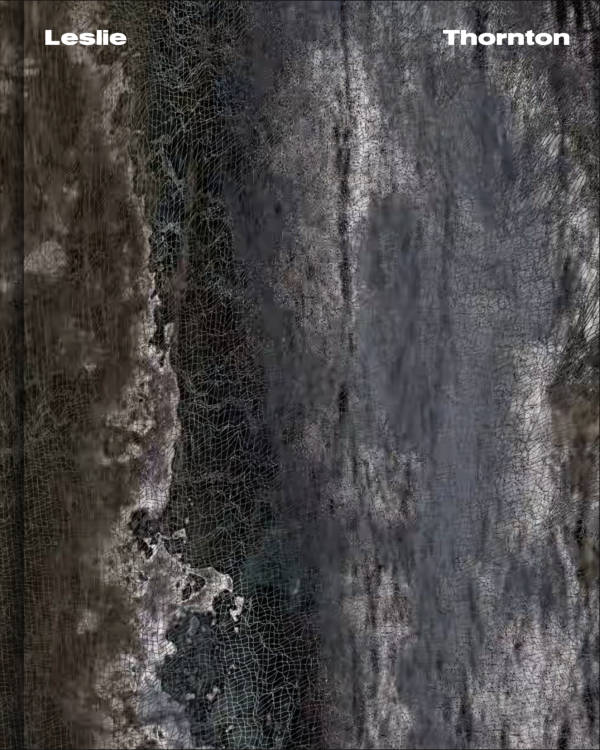
Leslie Thornton
Leslie Thornton, Natalie Bell and 2 more
Produced on the occasion of Leslie Thornton's major solo exhibition at the MIT List Visual Arts Center as well as a recent solo exhibition at Kunstverein Nurnberg, this richly illustrated volume is the first monograph on this important artist and filmmaker, offering essential, foundational scholarship on Thornton's influential work in film and video.
Since the mid-1970s, American avant-garde filmmaker and artist Leslie Thornton (born 1951) has produced an influential body of work in film and video. Thornton's early encounters with experimental, structuralist, and cinéma vérité traditions fueled her iconoclastic take on the moving image and gave shape to her practice of weaving together her own footage and voice with archival film and audio. In part through her forceful and dynamic use of sound, Thornton exposes the limits of language and vision in her works, while acknowledging the ways that language and vision nevertheless remain central to scientific discourse and narrative in general. Her work consistently interrogates modes of representation and the violence of looking, pushing beyond critiques of the gaze to consider biases in perception, or the way voice and sound can undermine an otherwise dominant visual narrative.

Spike #71 – Couples
For the latest Spike – #71: Couples—we're seeing double. This one is dedicated to partnerships in life, love, law, and labour. Whether you're a serial monogamist, married to your job, or sublimating your crushy feelings into all that you create, it's tough to deny the role that romance—or its absence—plays in shaping our subjectivities.
Might coupling be key to seeing beyond the self, opening us up to a more expansive, collaborative (co)existence? And do relationship breakdowns parallel wider social strife? Can the dusty old dyad be reconceived as radical? What happens when art-world couples blend business and pleasure?
Curl up with your soul mate—or settle into singledom—and grab a copy to read about the uses of love beyond love; the motivation posed by muses and rivals; psychoanalytic takes on partners' promises; along with artist-couples, curatorial duos, rom-com heroes, spectres, fembots, and beyond.
With Chris Kraus, Asa Seresin, Whitney Mallett, Alenka Zupančič, Johanna Hedva, Sam Kriss, Calla Henkel & Max Pitegoff, Genesis & Lady Jaye Breyer P-Orridge, Darian Leader & Jamieson Webster, Eva & Franco Mattes, Tea Hacic-Vlahovic, and many more.
Founded by the artist Rita Vitorelli in 2004, Spike (Spike Art Quarterly) is a quarterly magazine on contemporary art published in English which aims at sustaining a vigorous, independent, and meaningful art criticism. At the heart of each issue are feature essays by leading critics and curators on artists making work that plays a significant role in current debates. Situated between art theory and practice and ranging far beyond its editorial base in Vienna and Berlin, Spike is both rigorously academic and stylishly essayistic. Spike's renowned pool of contributing writers, artists, collectors and gallerists observe and reflect on contemporary art and analyse international developments in contemporary culture, offering its readers both intimacy and immediacy through an unusually open editorial approach that is not afraid of controversy and provocation.

DWOSKINO. The Gaze of Stephen Dwoskin
Henry K Miller, Rachel Garfield
DWOSKINO. The Gaze of Stephen Dwoskin is the culmination of a three year research project, The Legacies of Stephen Dwoskin, at the University of Reading where his archive is housed. The book is a unique visual distillation of Dwoskin’s life and times, with hundreds of never-seen-before images taken from his archive, and texts by among others Laura Mulvey, Raymond Bellour, Raymond Durgnat, and Dwoskin himself.
Stephen Dwoskin (1939–2012) began his filmmaking career in the New York underground scene of the early 1960s, then moved to London in 1964, where he became a leading figure in avant-garde film, and was one of the founders of the London Filmmakers Co-operative (now LUX). His early works, such as Dyn Amo (1972), are synonymous with the male gaze. Laura Mulvey wrote that he ‘opened a completely new perspective for me on cinematic voyeurism’ and his work was a major influence on her influential work on the male gaze in cinema. From the mid-1970s, he focused his camera upon his own body, afflicted by polio during childhood, in such films as Behindert (1974) and Outside In (1981).
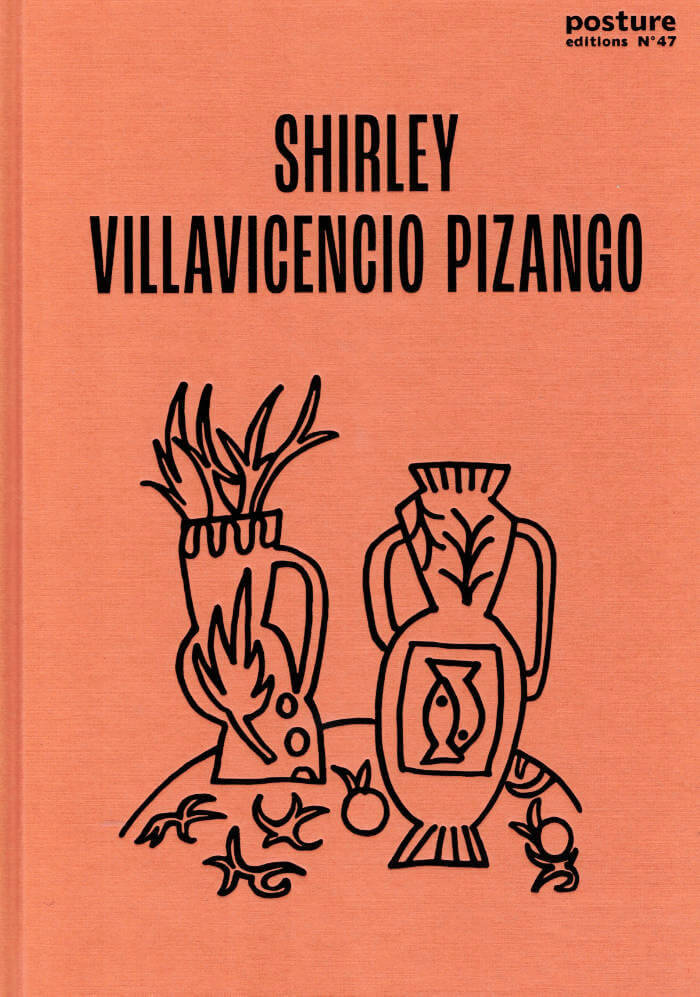
Dark Empathy
Shirley Villavicencio Pizango (b. 1988, Lima) is a Ghent-based artist with Peruvian roots. The cross-fertilization between her childhood in the Amazon jungle and Lima on the one hand, and her life in Belgium on the other, fundamentally characterizes her work.
Her young oeuvre consists of still lifes with terracotta vases, fruits or plants and decorative, colourful backgrounds. She also paints scenes for which mostly friends or family sit as models. Though it may seem that Shirley’s scenes are anchored in reality, the scenes on canvas have never taken place as a whole and her models have been transformed into characters in a constructed setting, where they are quietly allowed to be vulnerable or simply who they are.
Even the clothes and patterns are usually imaginary. Colours sometimes run; some parts appear to be left unfinished or blank.
Posture Editions N° 47, ‘Dark Empathy’, is a multi-layered hardcover presenting a selection of paintings from the last three years, interspersed with powerful drawings on paper and photographs of the artist in her studio. Bart Cassiman collected quotes to accompany the work and added some well-chosen observations by himself. The text ‘Inspired imagination’ by Benedicte Goesaert is the result of a frank conversation between the author and the expressive, generous, self-confident, but at times also melancholy artist.
"White lips refer to my memories of those moments I could not communicate with anyone because I did not yet master the Dutch language. At that time, I made drawings in which the mouth was altogether absent. Later it regained its place. The lips are often serenely pressed together because I want to immortalize the characters. For me, laughter is linked to the ephemerality of a moment. I find it fascinating to have the characters wait quietly without clear indication of what they are waiting for."
— Shirley Villavicencio Pizango in: Benedicte Goesaert, ‘Inspired Imagination’.

Oslo National Academy of the Arts
Towards a Transindividual Self
A book that examines the process of performing the self, distinctive for the formation of the self in Western neoliberal societies in the 21st century. It approaches the self from a transdisciplinary angle where political and cultural anthropology, performance studies and dramaturgy intersect.
Starting from their concern with the crisis of the social, which coincides with the rise of individualism, Vujanović and Cvejić critically untangle individualist modes of performing the self, such as possessive, aesthetic, and autopoietic individualisms. However, their critique does not make for an argument for collectivism as a socially more viable alternative to individualism. Instead, it confronts them with the more fundamental problem of ontogenesis: how is that which distinguishes me as an individual formed in the first place? This question marks a turning point in the study, where it steps back into the process of individuation, prior to, and in excess of, the individual.
The process of individuation, however, encompasses biological, social, and technological conditions of becoming whose real potential is transindividual, or more specifically, social transformation. A ‘theater of individuation’ (Gilbert Simondon) captures the dramaturgical stroke by which the authors investigate social relations (like solidarity and de-alienation) in which the self actualizes its transindividual dimension. This epistemic intervention into ontogenesis allows them to expand the horizon of transindividuation in an array of tangible social, aesthetic and political acts and practices. As with every horizon, the transindividual may not be closely at hand; however, it is certainly within reach, and the book encourages the reader to approach it.
"Towards a Transindividual Self is an ambitious and capacious effort to theorize a new way to approach collectivity for political purposes through the lens of performance. Convinced that the current neoliberal conjuncture has only heightened a form of capitalist individualism that blocks notions of the social, the authors aim to show that a "transindividual formation of the self can bring about different courses of action and a more socially driven imagination." Transindividuation, they assure us, shows how "we form ourselves on the basis of interdependence, sharing, commonality, as well as indispensability of the individual as the agent of creativity/ knowledge, freedom, and change, who 'possibilizes' their own conditions of formation."
— Professor Janelle Reinelt (University of Warwick), co-editor of Critical Theory and Performance (University of Michigan, 2006)
"Perhaps the most striking thing about this book is the manner in which it is able to engage with multiple discourses from political theory to aesthetics. In this way it both follows the ambitious scope of Simondon’s work on individuation, and expands into areas that Simondon did not cover, most notably politics and cultural politics, which is the book’s central concern. Rather than ask the question is the individual imagined or real, an effect of social relations or their distortion, the focus on the transindividual makes it possible to grasp individuation as a process: “Instead of pondering how the passage from one to many occurs, individuation permits us to immediately trace a bidimensional process in which both individual persons and the collectivities they form are altered. Another meaning of the crisis of the social has brought about a perfect slogan of such a process of transindividuation: ‘No one will be left alone in the crisis.” (…) Towards a Transindividual Self does a brilliant job of not only arguing for the importance and relevance for the transindividual as a concept for politics, performance, and the politics of performance, but of demonstrating a bold standard for political and aesthetic inquiry."
— Professor Jason Read (University of Maine), author of The Politics of Transindividuality (Brill, 2015)
Co-published by Oslo National Academy of the Arts, Sarma and Multimedijalni institut.
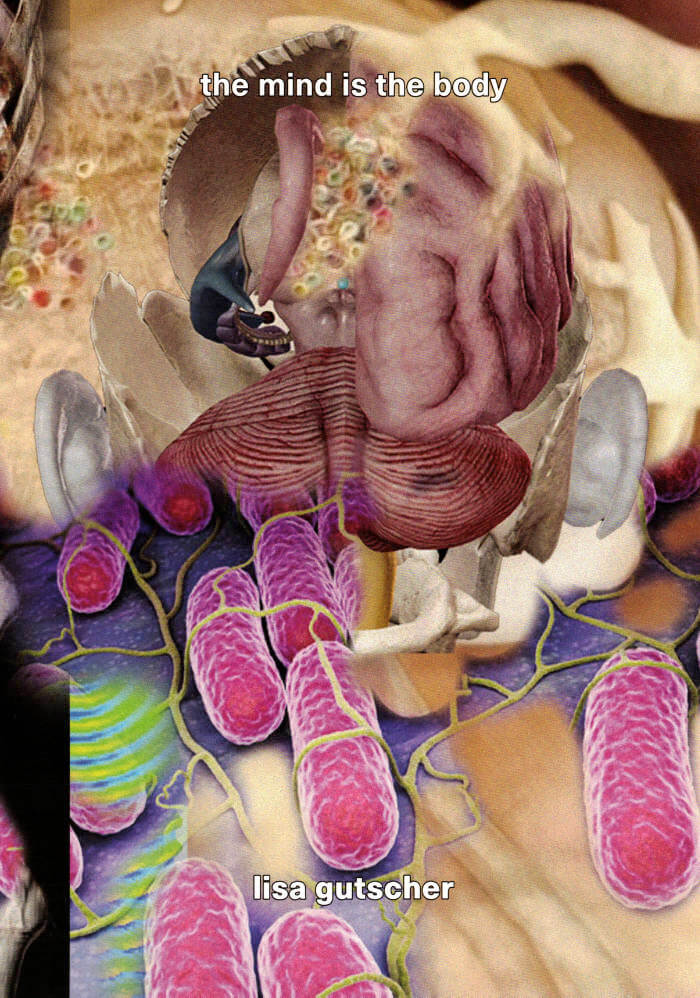
the mind is the body
Printed on thick cardboard, this book throws you right back into the child-like explorer mode we know from when we were young. It illustrates the mindful written words of Lisa Gutscher journey through the inner body based on a large archive from found images, screenshots and other image sources to unfold a whole new world in front of your eyes.

Top Stories
Top Stories was a prose periodical published from 1978 to 1991 by the artist Anne Turyn in Buffalo, New York, and New York City. Over the course of twenty-nine issues, it served as a pivotal platform for experimental fiction and art through single-artist issues and two anthologies. The entire run of Top Stories is collected and reproduced here across two volumes.
Top Stories primarily featured female artists, though in Turyn’s words a few men “crept in as collaborators.” Although primarily “a prose periodical” (as its byline often stated), the issues varied in form and aesthetics, pushing the boundaries of what prose could be and, from time to time, escaping the genre altogether. In fact, the only parameters required for participants were that the periodical’s logo and issue list be included on the front and back covers, respectively.
A great deal of the works are short stories by the likes of Pati Hill, Tama Janowitz, and Kathy Acker, whose Pushcart Prize–winning “New York City in 1979” appeared for the first time in book form as part of the series. Constance DeJong contributes “I.T.I.L.O.E.,” a widely unavailable work that features the artist’s trademark prose and is sure to please fans of her novel, Modern Love. The largest issue of the periodical is undoubtedly Cookie Mueller’s “How to Get Rid of Pimples,” which consists of a series of character studies of friends interspersed with photographs by David Armstrong, Nan Goldin, and Peter Hujar altered with freshly drawn blemishes.
Top Stories also celebrates less conventional literary forms. Issues by Lisa Bloomfield, Linda Neaman, and Anne Turyn take the form of artists’ books, juxtaposing image and text to construct tightly wound, interdependent narratives. Jenny Holzer and Peter Nadin present a collaborative work in copper ink comprised of truisms by Holzer on corporeal and emotional states and drawings by Nadin of abstract bodies. Janet Stein contributes a comic, while Ursule Molinaro provides a thorough index of daily life (and the contempt it produces) consisting of entries that were written just prior to lighting a cigarette.
Top Stories remains vitally defiant, an essential witness to what was the downtown literary and art-world underground.
Primary contributors include Kathy Acker, Laurie Anderson, Sheila Ascher, Douglas Blau, Lisa Bloomfield, Linda L. Cathcart, Cheryl Clarke, Susan Daitch, Constance DeJong, Jane Dickson, Judith Doyle, Lee Eiferman, Robert Fiengo, Joe Gibbons, Pati Hill, Jenny Holzer, Gary Indiana, Tama Janowitz, Suzanne Johnson, Caryl Jones-Sylvester, Mary Kelly, Judy Linn, Micki McGee, Ursule Molinaro, Cookie Mueller, Peter Nadin, Linda Neaman, Glenn O’Brien, Romaine Perin, Richard Prince, Lou Robinson, Janet Stein, Dennis Straus, Sekou Sundiata, Leslie Thornton, Kirsten Thorup, Lynne Tillman, Anne Turyn, Gail Vachon, Brian Wallis, Jane Warrick, and Donna Wyszomierski.
David Armstrong, Nan Goldin, JT Hryvniak, Peter Hujar, Nancy Linn, Trish McAdams, Linda Neaman, Marcia Resnick, Michael Sticht, and Aja Thorup all make appearances as well, contributing artwork for the covers or as illustrations.
Anne Turyn (b. 1954) is a photographer based in New York. Turyn’s work has been exhibited at the Museum of Modern Art, the Metropolitan Museum of Art, Kunsthalle Bern, Denver Art Museum, Walker Art Center, and Los Angeles County Museum of Art.
Published by Primary Information, 954 pgs, 21.6 × 14 cm, 2 Paperback books in Slipcase, 2022

Confidences / Majority
The uprising was staged by the minority, and a downfall is remembered by the majority.
Gilgamesh “Gil” Gupta is a theatre maker and self-defined “avant-gardist.” As a young vampire, Gil’s alienation from time, body, and identity only increases with the murder of his sire, Patrice. Seasons pass in spite of this, and Gil endeavours to circumvent inter-species edicts to foster a meaningful audience. Recognition becomes a vocation.
Confidences / Majority is a novel that presents entertainment as critical gospel. Seething a trail of cultural debris, Majority is the second instalment in Ivan Cheng’s Confidences series, which deploys a version of the vampire and performance as sites for transformation and maintenance.
Ivan Cheng (b. 1991, Sydney) produces films, objects, paintings and publications as anchors for the staging of complex and precarious spectacles. His background as a performer and musician form the basis for his using performance as a critical medium and questioning publics and accessibility. He holds an MFA in Critical Studies from Sandberg Instituut; his work has recently been presented at Voiture14 (Marseille), La Maison Pop (Montreuil), Les Urbaines (Lausanne), Volksbühne Roter Salon (Berlin), Oude Kerk (Amsterdam), Belvedere21 (Vienna), MuHKA (Antwerp), Carriageworks (Sydney), Federation Square (Melbourne). In 2017 he initiated the project space bologna.cc in Amsterdam.
Confidences / Majority is published simultaneous to Cheng’s solo presentation Milieu at Édouard Montassut, Paris.

Responses to Derek Jarman’s Blue
Responses to Derek Jarman's Blue is the third publication in a series of anthologies from Pilot Press seeking contemporary responses to works of art made during the AIDS crisis.
In this third iteration, responses were sought to the 1993 film Blue by the multidisciplinary artist Derek Jarman.
Contributors
In order of appearance
Roelof Bakker
Jared Davis
Becca Albee
Linda Kemp
Ashleigh A. Allen
David Nash
Sam Moore
Anton Stuebner
Gonçalo Lamas
Olivia Laing
Nate Lippens
Jason Lipeles
JP Seabright
Andrew Cummings
Sig Olson
Maria Sledmere
Cleo Henry
Jessie McClaughlin
Lars Meijer
Scott Treleaven
Declan Wiffen
Caitlin Merrett King
Harry Agius
António Manso Preto
Adriana Lazarova
Brooke Palmieri
D Mortimer
Mary Manning
Aaron James Murphy
Printed on 100% recycled paper
Published by Pilot Press, 20 × 15 cm, Softcover, 2022
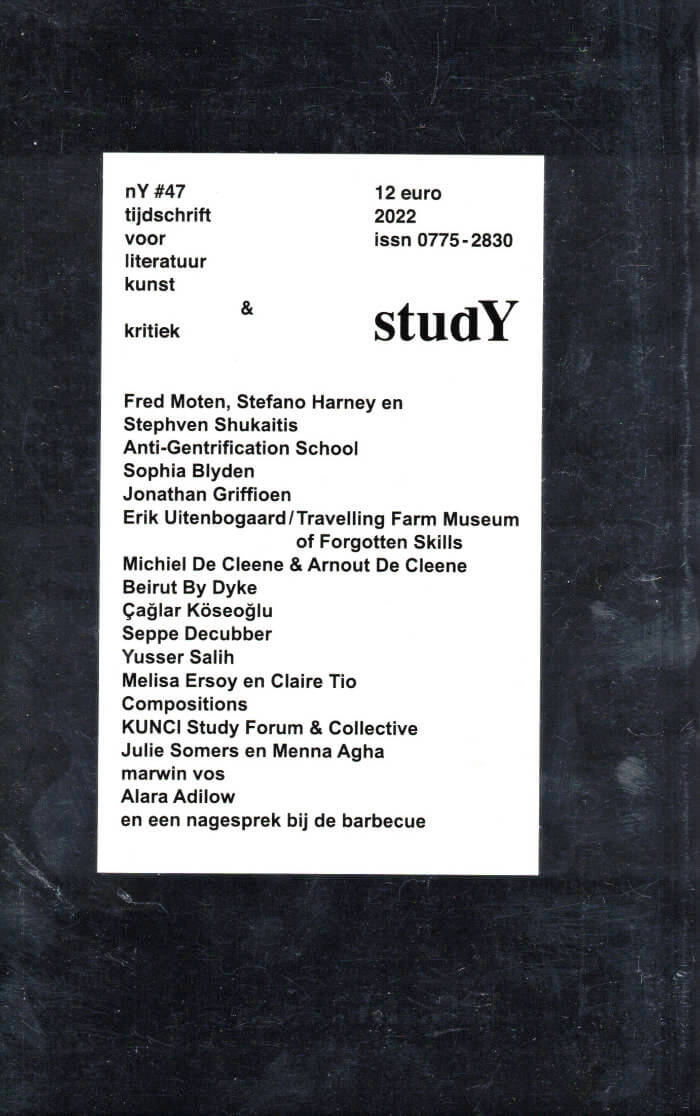
nY47 — studY
nY47 over studY verzamelt theoretische reflecties en praktijken rond of over study, geïnspireerd op het werk van Fred Moten en Stefano Harney. We vatten dit op als een praktijk van samenkomen om na te denken over wat je samen wilt leren, zonder dat hier een duidelijk einddoel aan verbonden is, zonder dat je er individueel punten voor of andere voordelen voor behaalt – zonder een instrumentele logica, kortom.
Redactie: Lietje Bauwens, Persis Bekkering, Hans Demeyer, Dagmar Bosma, Frank Keizer, Çağlar Köseoğlu, Julie Somers, Nadia de Vries.

Slangen
Slangen krioelen in de sarcofaag van het heden, in de krochten van de popcultuur, in de mummie van de natuur, in wondes en rot vlees, in artificiële woestijnen en op geoliede dad bods. Ze wentelen zich rond beursgrafieken, raken verstrengeld met wurgende algoritmes, orkestreren een trage ondergrondse revolutie. Een meisje snijdt zich aan een nepdiamanten piramide en werpt haar slangenvel van zich af.
Dominique De Groen is schrijver en beeldend kunstenaar. Ze publiceerde de dichtbundels Shop Girl (2017), Sticky Drama (2019) en offerlam (2020). Ze werd genomineerd voor de Poëziedebuutprijs Aan Zee 2018, de Herman de Coninckprijs 2020 en de Fintroliteratuurprijs 2021 en won de Frans Vogel Poëzieprijs 2019 en de Fintropublieksprijs 2021.

Time Is A Mother
How else do we return to ourselves but to fold
The page so it points to the good part
In this deeply intimate second poetry collection, Ocean Vuong searches for life among the aftershocks of his mother's death, embodying the paradox of sitting within grief while being determined to survive beyond it. Shifting through memory, and in concert with the themes of his novel On Earth We're Briefly Gorgeous, Vuong contends with personal loss, the meaning of family, and the cost of being the product of an American war in America. At once vivid, brave, and propulsive, Vuong's poems circle fragmented lives to find both restoration as well as the epicenter of the break.
The author of the critically acclaimed poetry collection Night Sky With Exit Wounds, winner of the 2016 Whiting Award, the 2017 T. S. Eliot Prize, and a 2019 MacArthur fellow, Vuong writes directly to our humanity without losing sight of the current moment. These poems represent a more innovative and daring experimentation with language and form, illuminating how the themes we perennially live in and question are truly inexhaustible. Bold and prescient, and a testament to tenderness in the face of violence, Time Is a Mother is a return and a forging forth all at once.
![Cover of OEI #94-95 Geografier [Geographies]](https://rile.space/storage/1488/0216_Scan2022-04-15_140650_004.jpg)
OEI #94-95 Geografier [Geographies]
Jonas J. Magnusson, Cecilia Grönberg and 1 more
The new publication triangulates between geopoetics, geopolitics, and cultural geography; a 464 page issue with some 50 contributors as well as a large section on Swedish philosophical geographer Gunnar Olsson.

Stili Drama XIII-XXI / La Giostra di Lulu XLI-XLIV
The materials collected in the publication have been developed departing from the documentation, transcription and translation of textual, visual, sculptural and audio materials produced between March and November 2021 for STILI DRAMA.
STILI DRAMA is an open-ended episodic para-cinematographic project, which functions as a spontaneous expression of MRZB research. STILI DRAMA XVIII-XXI and LA GIOSTRA DI LULU XLI-XLIV are the two first fragments of the work.
Language: English, Italian
Edition of 100 copies

Hatred of Sex
Hatred of Sex links Jacques Rancière's political philosophy of the constitutive disorder of democracy with Jean Laplanche's identification of a fundamental perturbation at the heart of human sexuality. Sex is hated as well as desired, Oliver Davis and Tim Dean contend, because sexual intensity impedes coherent selfhood and undermines identity, rendering us all a little more deplorable than we might wish. Davis and Dean explore the consequences of this conflicted dynamic across a range of fields and institutions, including queer studies, attachment theory, the #MeToo movement, and "traumatology," demonstrating how hatred of sex has been optimized and exploited by neoliberalism.
Advancing strong claims about sex, pleasure, power, intersectionality, therapy, and governance, Davis and Dean shed new light on enduring questions of equality at a historical moment when democracy appears ever more precarious.

Five Essays from Present Continuous
The five essays printed here are excerpted from Part I of Present Continuous, a book of prose written during the first year of the coronavirus pandemic between March 2020 and April 2021 in Lewisham, London.
The essays in the present volume were written between March 2020 and June 2020: the movement from spring to summer, from the first announcement of a national lockdown to the Black Lives Matter protests sparked by the murder of George Floyd and Breonna Taylor in the United States and the death of Belly Mujinga in the UK. Nearly two years on, following a seemingly endless series of virus variants and subvariants, an apparent shift from pandemic to endemic, and a kind of exhaustion of vocabulary and will, I hope they provide some sort of record, not just of where “we” were in 2020, but where “we” are – or might be – now. (David Grundy, London, January 2022)
“It’s 2018 and we’re still on a train out of London, it’s 1967 or 1970 and Coltrane and Ayler are still in their material form, it’s 1943 and Artaud’s letters spill their remainder on the page, it’s April 2020 and all those presences are gone but their traces remain in the split voice, the overtone, the greater frequency overwhelming that base note which no longer guides in circumscribed lines. The actual presence of actual ghosts, silver on the mirrors, lost poetry, the noise it makes. It’s from the condition of being in the abyss itself that we learn how to climb out of it.”
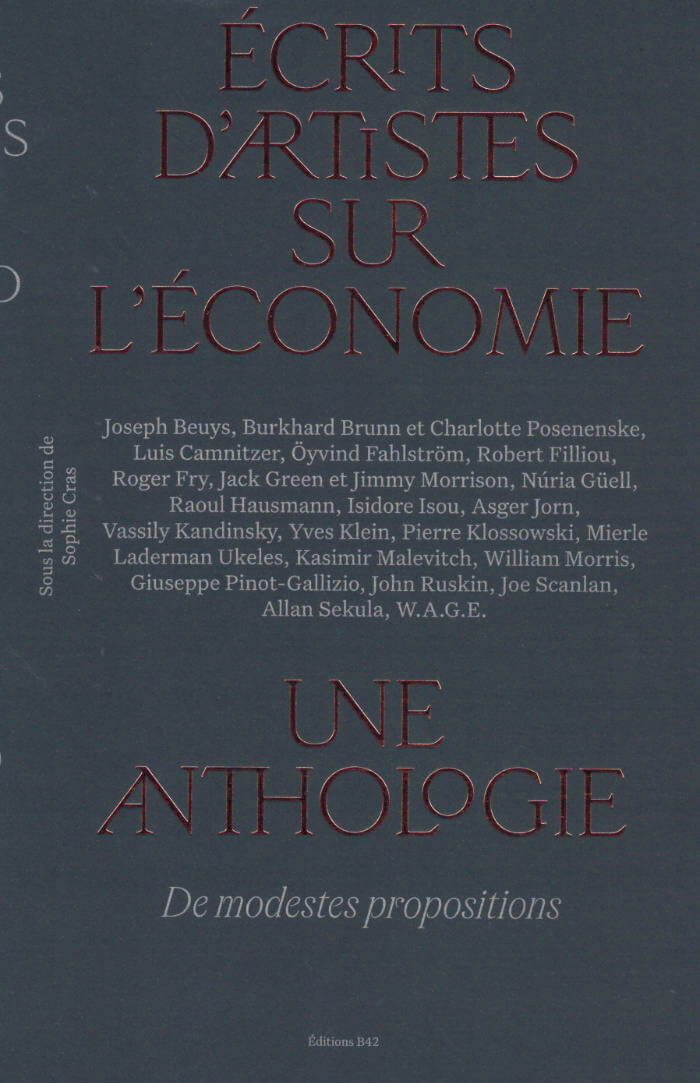
Écrits d'Artistes Sur L'Économie
Qu’advient-il de l’économie lorsqu’elle est pensée, inventée et rêvée par les artistes ? On le sait peu, mais nombreux furent celles et ceux qui, de la fin du XIXe siècle jusqu’à aujourd’hui, se firent un temps économistes, allant jusqu’à rédiger de véritables traités dont l’ambition affichée était de renouveler la discipline de fond en comble.
Qu’ils aient suivi une formation universitaire en économie, construit leur conception théorique de l’art en dialogue avec des économistes, ou élaboré un système théorique à part entière, ces artistes nous livrent une vision riche et singulière, tant sur la pensée économique de leur temps que sur les enjeux actuels. Valeur, travail, monnaie et capitalisme – autant de thèmes scrutés et revisités par ces textes, dont le présent ouvrage se propose de faire l’anthologie.
Avec: Joseph Beuys, Burkhard Brunn, Luis Camnitzer, Sophie Cras, Öyvind Fahlström, Robert Filliou, Roger Fry, Jack Green, Núria Güell, Raoul Hausmann, Isidore Isou, Asger Jorn, Vassily Kandinsky, Yves Klein, Pierre Klossowski, Mierle Laderman Ukeles, Kasimir Malevitch, William Morris, Jimmy Morrison, Giuseppe Pinot-Gallizio, Charlotte Posenenske, John Ruskin, Joe Scanlan, Allan Sekula, W.A.G.E. (Working Artists and the Greater Economy).
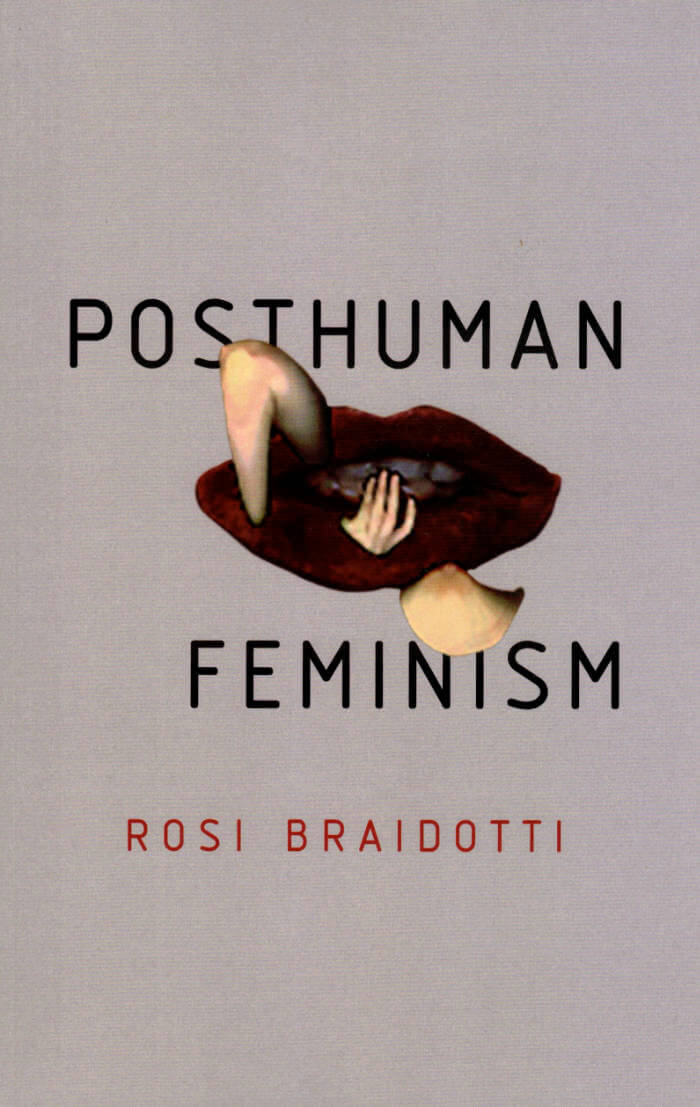
Posthuman Feminism
In a context marked by the virulent return of patriarchal and white supremacist attitudes, a new generation of feminist activists are continuing the struggle: these are very feminist times. But how do these and other movements relate to the contemporary posthuman condition?
In this important new book, Rosi Braidotti examines the implications of the posthuman turn for feminist theory and practice. She defines the posthuman turn as a convergence between posthumanism on the one hand and post-anthropocentrism on the other, and she examines their complex relationship and joint impact. Braidotti claims that mainstream posthuman scholarship has neglected feminist theory, while in fact feminism is one of the precursors of the posthuman turn, through diverse social movements and political traditions. Posthuman Feminism is an analytic and creative response to contemporary conditions and a call to action. It highlights the constraints but also the potentialities available to feminist political subjects as they confront the ever-growing injustices of sexism, racism, ecocide and neoliberal capitalism.
This bold new text by a leading feminist philosopher will be of great interest to students and scholars throughout the humanities and social sciences.
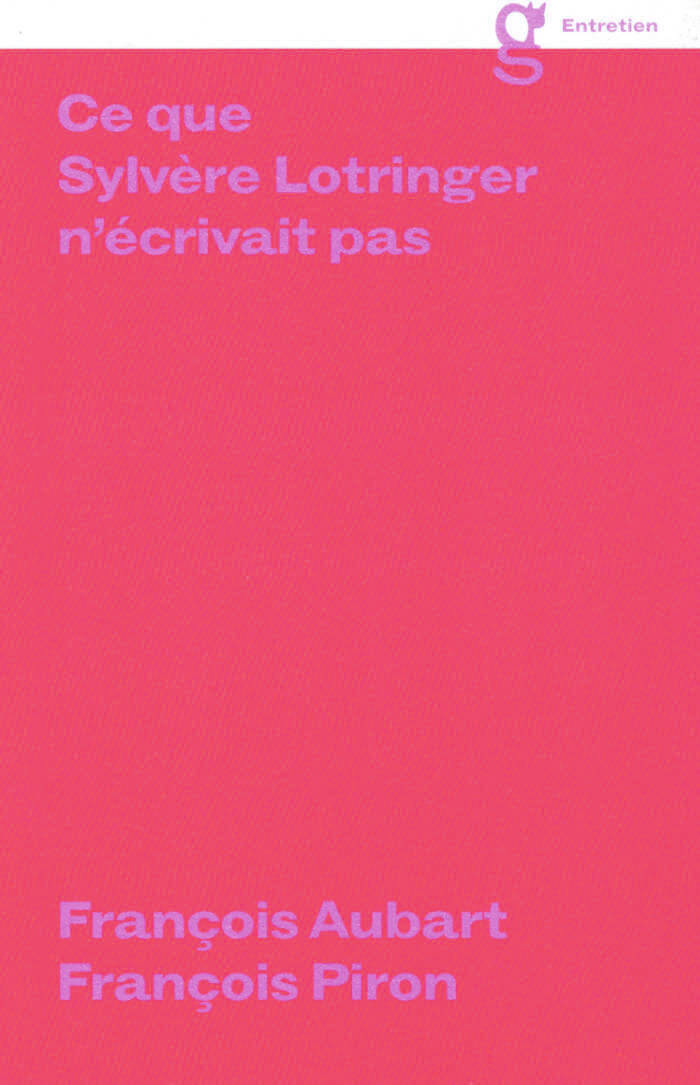
Ce que Sylvère Lotringer n'écrivait pas
François Piron, François Aubart and 1 more
A book of interviews with Sylvère Lotringer.
French philosopher Sylvère Lotringer (1938-2021) was the general editor of Semiotext(e). A younger contemporary of Gilles Deleuze, Félix Guattari, Jean Baudrillard, Paul Virilio and Michel Foucault, he was one of the main introducers and interpreters of French Theory in the United States. He is the author of Overexposed: Perverting Perversions (Semiotext(e), 2007).
François Aubart is an art critic, independent curator and publisher (co-founder of <o> future <o> and Même pas l'hiver).
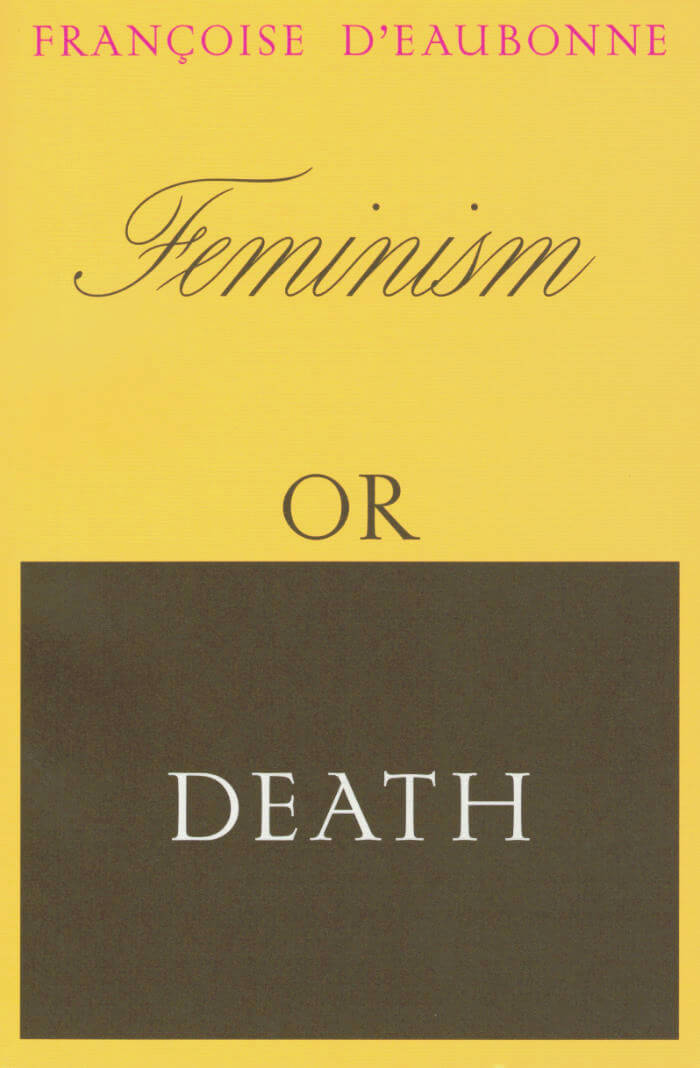
Feminism or Death
Originally published in French in 1974, radical feminist theorist Francoise d'Eaubonne's Feminism or Death surveyed women's status around the globe and argued that an internationalist feminism was not just about equality but about life or death - of humans and also of the planet.
D'Eaubonne first proposed a politics of "ecofeminisme," the idea that the patriarchal system also destroys the environment, and that feminism and environmentalism must be connected.

Dan Graham: Theatre
A facsimile of Graham's ultra-rare artist's book documenting early performance works.
Originally published in 1978 and produced here in facsimile form, Theatre is an artist's book documenting seven early performance works by Dan Graham (born 1942) taking place from 1969 to 1977, with notes, transcripts and photo documentation for each performance. These performances catch the artist at a unique moment, as he shifts away from his early media works and towards his hallmark video and written work around underground music and youth culture.
The works in Theatre focus primarily on the psychological and social space between individuals and the roles they serve inside the arena of performance, subverting them by creating conditions by which a performer or audience simultaneously functions as both (creating a type of feedback loop through social transgression). Like most of Graham's work, these performances also serve as a critique of cultural norms, with many of the performances utilizing quotidian, social acts that are amplified over time.

Xenogenesis
An extensive and comprehensive polyphonic exploration of the work of The Otolith Group, coming at a pivotal point in their practice.
The work of this London-based artist's collective comprised of Anjalika Sagar and Kodwo Eshun covers politics of race and diversity and incorporates film making and post-lens-based essayistic aesthetics that explore the temporal anomalies, anthropic inversions, and synthetic alienation of the posthuman, the inhuman, the non-human, and the complexity of the environmental conditions of life we all face.
Presenting all bodies of work contained in the Xenogenesis exhibition, this publication includes many materials and graphics from The Otolith Group's broader practice, including performance, lecture and research material. The outcome of over four years of collaboration, research and conversation, the publication is not a chronological exhibition catalogue or retrospective but a cross-section of their work which includes substantial contributions from the artists themselves, in the form of writing and direct engagement with its production.
The publication also brings together important thinkers, scholars, art historians and writers from disparate fields, who know and have worked with the group, as well as those who are writing from a contemporary perspective. They include Denise Ferreira da Silva, Annie Fletcher, Anselm Franke, Shanay Jhaveri, George E. Lewis, Mahan Moalemi, Fred Moten, Grant Watson, Vivian Ziherl and the late Mark Fisher each of whom reflect on a particular aspect of the Group's practice with supplementary materials such as archival images, documented conversations, early lecture performances as well as other accompanying texts and examinations of their research sites.
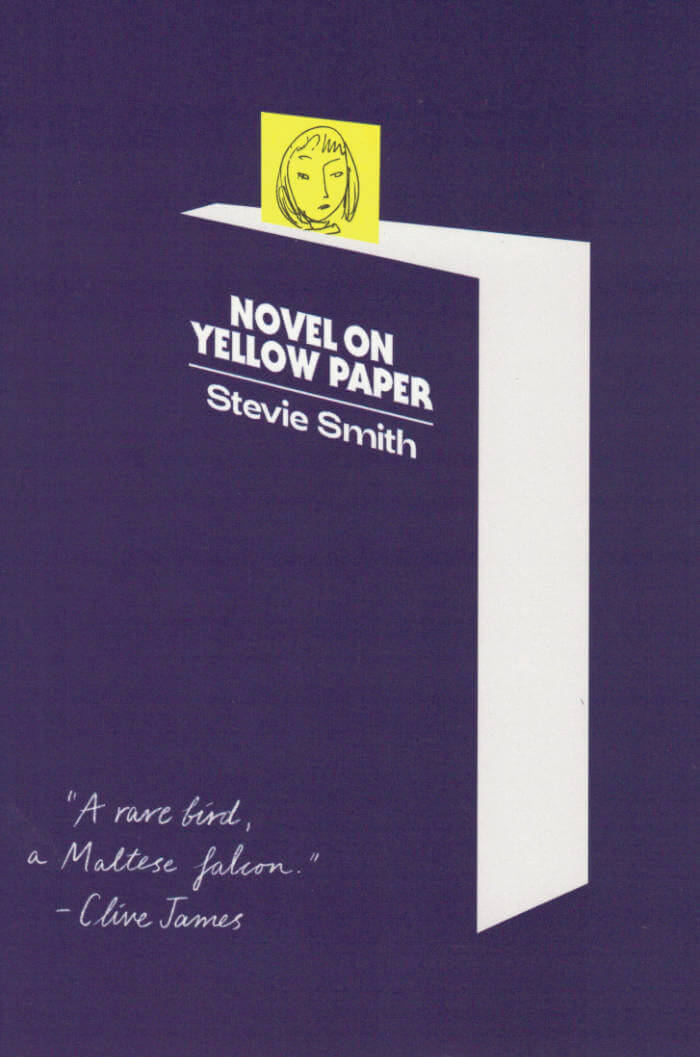
Novel On Yellow Paper
I am a forward-thinking girl, and don’t stay where I am. ‘Left right, be bright.’
Pompey Casmilus, Stevie Smith’s loquacious alter ego, works as a secretary and writes down on yellow office paper this wickedly amusing novel. “Dear Reader,” she addresses us politely in the whirlwind of her opinions on death, sex, anti-Semitism, art, Greek tragedy, friendship, marriage, Nazism, gossip, and the suburbs. But most of all Pompey talks about love.
When Smith first tried to get her poems published in 1935, she was told by a publisher to “go away and write a novel.” Novel on Yellow Paper, the happy result of this advice, made its author an instant celebrity and was acclaimed as “a curious, amusing, provocative and very serious piece of work” (The London Times Literary Supplement, 1936).
Published 1936, 2022
Stevie Smith (20 September 1902 – 7 March 1971), was an English poet and novelist.